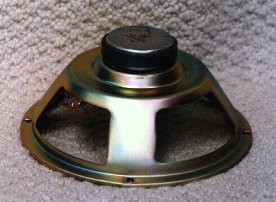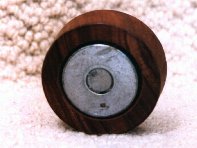A Magnetic Block
by Russell Housden
While making a bookcase and bench for a computer workstation, I again confronted the annoying requirement of using a scrap piece of wood to protect the work while clamping up. For some time I had had the idea of using an old magnet to hold a protective piece of timber/MDF to a G clamp while clamping - the idea is great.

On completion of the job, for which I shall detail in a moment, I realised that this project would make an ideal first piece for a virgin/not so virgin wood turner.
So, to my Mag Block
Referring to photo above, it can quite easily be seen exactly what is intended. No exact dimensions are needed, all can be done by eye and any piece of off-cut will do. The centre from a hole is perfect.

In my case I had just drilled a 50mm hole through 19mm MDF to take the computer cables under my new bench top and thought - why not, its perfect. A nice round blank and just the right size.
I have over the years used magnets for all sorts of things and selected one from a discarded 75mm speaker. The magnet size I found the best was a diameter of between 30 - 45mm with a depth of 10 - 20mm.
A smaller magnet than 30 x 10mm you may find does not have sufficient magnetic grunt for a woodies freestyle tendencies.
Using a magnet larger than 45 x 20 mm will give you a finished size of about 65 mm diam. x 25 mm thick, which is fine, but bigger is probably too big

To release the magnet from the speaker shell I found an angle grinder the best tool. Remember to always use eye, ear and hand protection and make sure you note before you pull the trigger where the sparks are going to go. No prizes for more holes in your pants or a fire in your rubbish bin.
I have made two sizes of Mag Blocks. A completed size of 50mm diam. x 19mm thick and a 65mm diam. x 25mm thick, both of which I found work well. The Mag Blocks advantage is that it allows you to position the G Clamp with the protective block attached, with one hand while holding the work piece or tightening the G Clamp with the other.

The order of things is to come by your magnet first, noting its dimensions. Add approximately 5 - 6mm to its depth and approximately 20mm to its diameter then select your blank. I have used MDF as I have said and Red Gum (ex fence post) for the larger and found both fine, however anything should do the trick.
A new-comer to turning may like to rough the blank down between centers, remount it in a suitable chuck or face plate so as to open out the hole to accept the magnet. You could even try remounting it in a cup chuck to finish the other side for practice. If the magnet appears a little loose in your hole never fear, as it will be glued in place. Make sure the magnet has the sticky bit on the outside prior to gluing or she no worky. See below.
A hot glue gun is ideal for the job of fixing the magnet in its recess however, any wood & metal adhesive will do. If a glue gun is used, I suggest you pre-heat the magnet and the protective block first with a hair dryer to allow the positioning of the magnet level with the outside of the block. A convenient way of doing this is to attach the magnet to the open jaws of your vice. This will guarantee that you have the magnet around the right way. Apply the adhesive into the recess of your block, place the block over the magnet smartly and tighten the vice/clamp - excessive tightening is not required. Leave until the glue has set. If you use a relatively fluid glue you may find it helpful to mount a G or sliding clamp in your vice vertically, attaching your magnet to the upper jaw & proceed as above.
If you find that the magnet has not ended up flush with the outside of the block after being glued in place, never fear as the majority of your clamps have floating heads. The problem just mentioned can happen quite easily when using a heat gun if you muck around too much while gluing up. i.e. preheat the job to give you more time to position your work.
For all those non-virgin woodies that just want my Mag Block yesterday, drill out your blank with a hole saw. Hold the blank by any means available and counter sink a hole the diameter and thickness of your magnet. A spade bit is perfect. A dab of hot melt or super glue and you're done.
originally on vicnet.net.au
